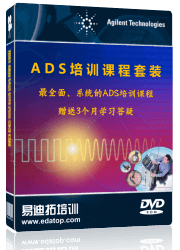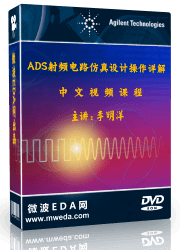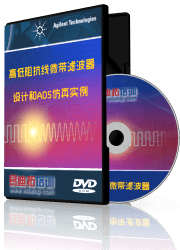- 易迪拓培训,专注于微波、射频、天线设计工程师的培养
ads diel2
I had just get started with the ADS software .. and i started with a simple tutorial found via the internet .. it contain a simple matching example ... its schematic is as shown in picture ...
my quistions are :
1- what is the S(1,1) ? is it a special parameter or it means the First element in the S-matrix ?
2 -What is the rectangular plot ?
3 -In the 'line calculator' what does the following parameters mean :
[ Hur , Cond , TanD , rough , Wall1 , Wall2 , Fa , Fb, Fdw ]
4 - for microstrip Transmission lines MLIN what is the difference between L,W and the other parameters H,T ? Do the latter ones stand for Hight and thickness ?
5 - What does the Msub do ? what is its funciton ?
Thank you very much .. and sorry i will ask more quistion later when i face further problems.. thanks for help
S11 is the reflection coefficient seen at port 1 towards the circuit. The lower the reflection coefficient, the better the match. In your case if S11 is low then the impedance looking into the network is close to 50 ohms. Rectangular chart is the typical XY axes plot. For instance, the Smith chat is a polar chart but you might want to see reflection coefficient versus frequency and it is easier to see on a rectangular chart. L is the length of the transmission line (MLINE) the distance between the two red connctors. W is the width of the line. MSUB is the material the line is on. For instance if you are making transmission lines on fiberglass board (FR4), the MSUB describes that materials. Your transmission line isn't in free space so the surrounding materials affect it.
i think you should get a book about the "rf and microwave circuit design" to study!
at first you can use the ADS tool better until y are very familiar with the basic theory of the "rf and microwave", there are many excellent book on this topic in the www.edaboard.com website, good lucks!
Thank you for help .. but you didn't answer the other quistions .. i.e. the Hu, Hur , T, H difference between them and W,L .. etc. please try to answer them if you can . thank you
Nah, he should just use some canned software and try to design microwave circuits without understanding any of the fundamental theory! It should be easy!
Sorry but i didn't understand what did you say ! what is canned software ?
I already know all these answers. Now its your turn...
ok .. if you know other quistions answers, why don't you answer them to me.. i told you before as i think that i am a newbie in RF .. and this approximately my first steps in this field .. try to help me if you can .. and thank you very much for your help :)
T= Thickness of the metallization
H= Height of the dielectric material
Hu : You can ignore
W: Width of the copper trace, L : length of the copper trace. You may look into the help file (press f1 in windows version) and look for explanations on transmission lines
Thank you for your help ... and i sorry i will need further help later if you don't mind ..
Also if you have some circuits that are useful to be simulated, send them as i am a newbie in the ADS now .. and want to learn it good .. thanks
i have noticed that your questions are basic and conceptual,may i suggest that you reinforce your theoritical background about analog design,microwave enginnering and RF circuits,you can start with G. gonzales 'microwave transistor amplifier design' for RF circuits,David pozar's 'microwave engineering' for basic microwave concepts(also a good book is Kraus/fleisisch ELECTROMAGNETICS has some good illustrations),it's a common practice to represent N port networks by their equivelent s,z,y parameters check R E collins for a good insight concerning that issue.then using @ds if u simply double click on the item of interest and press the help button it will give you a good explanation of the chosen item or at least some guiddelines to help you search for an explanation.that's how it works you learn ,read search try then ask questions ,that's what it takes to be a good designer .i have included a picture from the @ds help giving an explanation of the substarte parmeters and their physical relevance,just try harder first and good luck.
i hope this will be of some help
h0op
Parameters
H = substrate thickness, in specified units
Er = relative dielectric constant
Mur = relative permeability
Cond = conductor conductivity, in Siemens/meter
Hu = cover height
T = conductor thickness, in specified units
TanD = dielectric loss tangent
Rough = conductor surface roughness, in specified units; RMS value; refer to note 7
Cond1 = (ADS Layout option) layer on which the microstrip metallization will be drawn in layout
Cond2 = (ADS Layout option) layer on which the air bridges will be drawn in layout
Diel1 = (ADS Layout option) layer on which the dielectric capacitive areas will be drawn in layout
Diel2 = (ADS Layout option) layer on which the via between Cond and Cond2 masks will be drawn in layout
Hole = (ADS Layout option) layer on which the via layer used for grounding will be drawn in layout
Res = (ADS Layout option) layer on which the resistive mask will be drawn in layout
Netlist Format
Substrate model statements for the ADS circuit simulator may be stored in an external file.
model substratename MSUB [parm=value]*
The model statement starts with the required keyword model. It is followed by the substratename that will be used by microstrip components to refer to the model. The third parameter indicates the type of model; for this model it is MSUB. The rest of the model contains pairs of substrate model parameters and values, separated by an equal sign. The name of the model parameter must appear exactly as shown in the parameters table-these names are case sensitive. Model parameters may appear in any order in the model statement. For more information about the ADS circuit simulator netlist format, including scale factors, subcircuits, variables and equations, refer to "ADS Simulator Input Syntax" in the Circuit Simulation manual.
Example:
model Msub1 MSUB H=10 mil Er=9.6 Mur=1 Cond=1.0E50 \
Hu=3.9e+34 mil T=0 mil Tand=0 Rough=0 mil
Yes i am a beginner and wanna to improve my basics .. i got books you told me about .. thanks for suggesting them..
sorry .. but i didn't find the picture you mentiones ..
anyway .. thank you for your very useful help .. :)
Parameters
H = substrate thickness, in specified units
Er = relative dielectric constant
Mur = relative permeability
Cond = conductor conductivity, in Siemens/meter
Hu = cover height
T = conductor thickness, in specified units
TanD = dielectric loss tangent
申明:网友回复良莠不齐,仅供参考。如需专业帮助,请学习易迪拓培训专家讲授的ADS视频培训课程。
上一篇:Filter design unit in ADS
下一篇:ads layout site:edaboard.com
ADS中文视频培训教程 | More...
 国内最全面、最专业的Agilent ADS培训课程,可以帮助您从零开始,全面系统学习ADS设计应用【More..】
国内最全面、最专业的Agilent ADS培训课程,可以帮助您从零开始,全面系统学习ADS设计应用【More..】
- Agilent ADS教学培训课程套装
- 两周学会ADS2011、ADS2013视频教程
- ADS2012、ADS2013射频电路设计详解
- ADS高低阻抗线微带滤波器设计培训教程
- ADS混频器仿真分析实例视频培训课程
- ADS Momentum电磁仿真设计视频课程
- ADS射频电路与通信系统设计高级培训
- ADS Layout和电磁仿真设计培训视频
- ADS Workspace and Simulators Training Course
- ADS Circuit Simulation Training Course
- ADS Layout and EM Simulation Training Course
- Agilent ADS 内部原版培训教材合集









 沪公网安备 31011202014168号
沪公网安备 31011202014168号
 1427313829
1427313829 旺旺在线
旺旺在线 Skype Online
Skype Online 13761612886
13761612886 官方淘宝店
官方淘宝店
